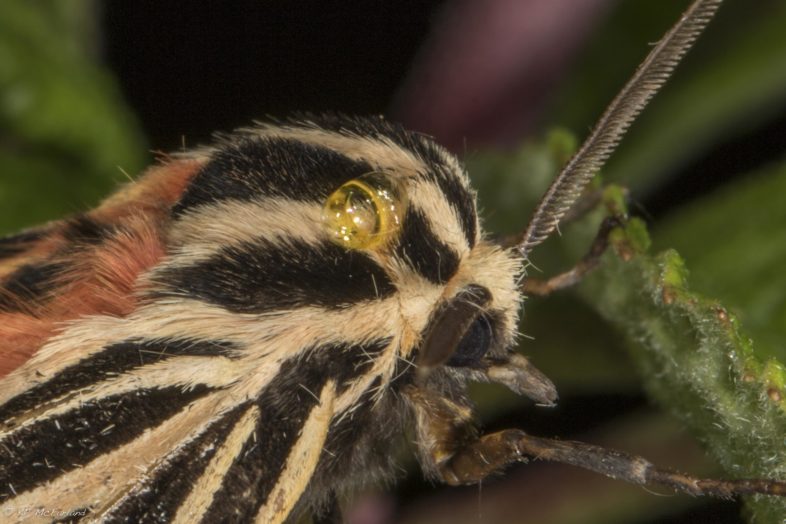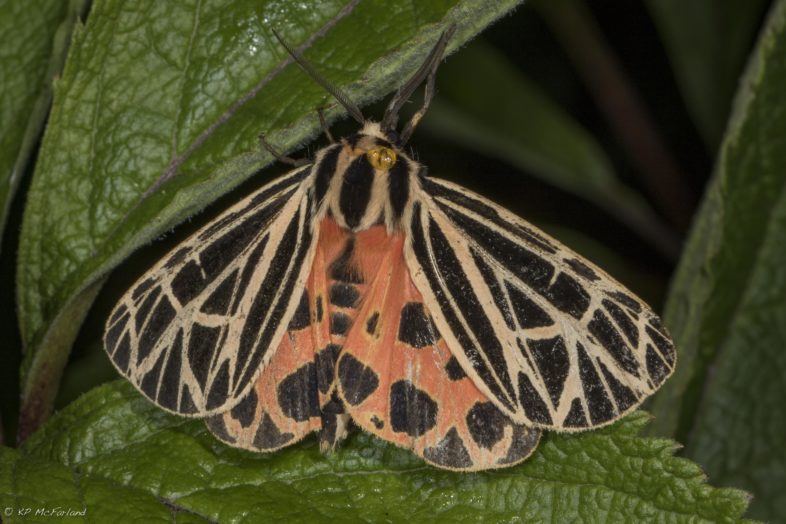
It’s National Moth Week. Here in Vermont we’ve discovered nearly 100 new species for the state just by mothing in our backyards for the Vermont Atlas of LIfe. For five bucks at a garage sale and the snip of a wire, this bug zapper was changed into my backyard moth light.
Seriously, don’t do this at home. I tasted a frothy moth secretion last night and it was downright awful. I should have known from the smell alone, which I can only describe as a strong, old attic odor. But I’ve heard for years that these tiger moths were wildly and brightly marked to warn predators of their awful taste, so I had to try it myself. And it’s true.
Last night I was mothing on the back deck and celebrating National Moth Week and a gorgeous Virgin Tiger Moth (Grammia virgo) fluttered onto my white sheet. I snapped a few shots of it and then I decided to move it to a nearby plant for a more natural looking image. I gently shifted it off the sheet and onto my hand and walked a few feet over to my pollinator garden. Almost immediately, a yellow, frothy goo began to ooze from the front corner of the moth’s thorax (the “shoulder” area).
It’s been long known that these moths have a nasty chemistry. In 1859, Thaddeus William Harris wrote in A Treatise on Some of the Insects of New England: Which are Injurious to Vegetation that, “The largest and most rare of these moths is the Arctia virgo, or virgin tiger moth. On account of the peculiarly strong and disagreeable odor it gives out, it might, with greater propriety, have been named the stinking tiger moth.” The same year in The Life of North American Insects, Jaeger and Preston wrote, “The Virgin Tiger Moth is one of the handsomest and largest of this genus, but on account of its fetid odor it is very disagreeable to handle.” And more recently in 2005, David Wagner wrote in his amazing book, Caterpillars of Eastern North America, that when “adults, when gently squeezed, may bubble generous amounts of their yellow “blood” out of the front corners of the thorax, yielding a frothy mass that contains alkaloids that the caterpillar has consumed.”
I dabbed a bit of the viscous material from the moth onto my forefinger and placed it on my tongue. Wagner’s note of alkaloids explains the intensely bitter taste on my tongue. I immediately went inside to rinse my mouth with water.

Closeup of the yellow liquid oozing from the Virgin Tiger Moth (Grammia virgo) after I picked it up. / © K.P. McFarland
For nearly 65 million years moths have been locked in battle with their predators. Bats developed ultrasonic sound to track moth prey at night. Moths countered with ears capable of hearing the bats. The bats responded by changing their frequencies. Tiger moths, responded with the ability to actually create their own ultrasonic sound. They are locked in a coevolutionary predator verses prey race for survival.
Many moths in the Noctuidae family have tiny organs in their ears that can hear the echolocation calls of bats. Weak calls, indicating the bat may be some distance away, causes the moth to flee from detection. A strong detection of an approaching bat instantly produces erratic flight. The moth’s wing muscles literally go into spasms causing their flight to be an unpredictable loop, twist or twirl. A last ditch effort by the moth is the complete folding of wings causing a free-fall. The moth responds to the detection of bat calls in a mere 40 to 100 milliseconds. Be quick or be eaten.
Diurnal tiger moths are more likely to use visual signals such as bright colouration to warn of their distastefulness to predators such as birds. Those that fly mostly at night rely more on sound to warding-off echolocating bats. The Virgin Tiger Moth that haunts my backyard has it all, bright color, bad taste and cloaking clicks in the night.


Fascinating!
Fascinating information! But tasting this proves that you’re batty for moths!
Be careful Kent or when the moon is full you mat start to fluttering by porch lights!
Nature is astounding!
l was not expecting you to eat a moth what the moth taste like sounds interesting you are insane to eat a moth
Agreed!🤓 (poor little guy…)